While rumors are already flying about Google’s next Pixel smartphone, today I’m testing their latest model, the Google Pixel 8 Pro. The latter was the subject of quite a few promises regarding the improvements that would be made to it.
Indeed, to sum up, the Pixel 8 Pro features an improved camera, a remarkable screen, a more powerful chip, a 7-year software support warranty and some design changes.
Design of the Google Pixel 8 Pro
First, as is my wont, I’d like to talk about the phone’s unboxing. There’s not much to discover, really. The Pixel 8 Pro comes in a fairly standard white cardboard box, with an image of the phone printed on the front.
Inside, I have to admit that the list of accessories is pretty short, so here it is:
- Pixel 8 Pro
- USB-C charging cable
- SIM drawer ejector pin
- USB-A to USB-C adapter
- A quick-start guide
That’s not much, of course, but it’s more than enough to be able to use the smartphone in its entirety. Let’s move on to a description of the device’s aesthetics.
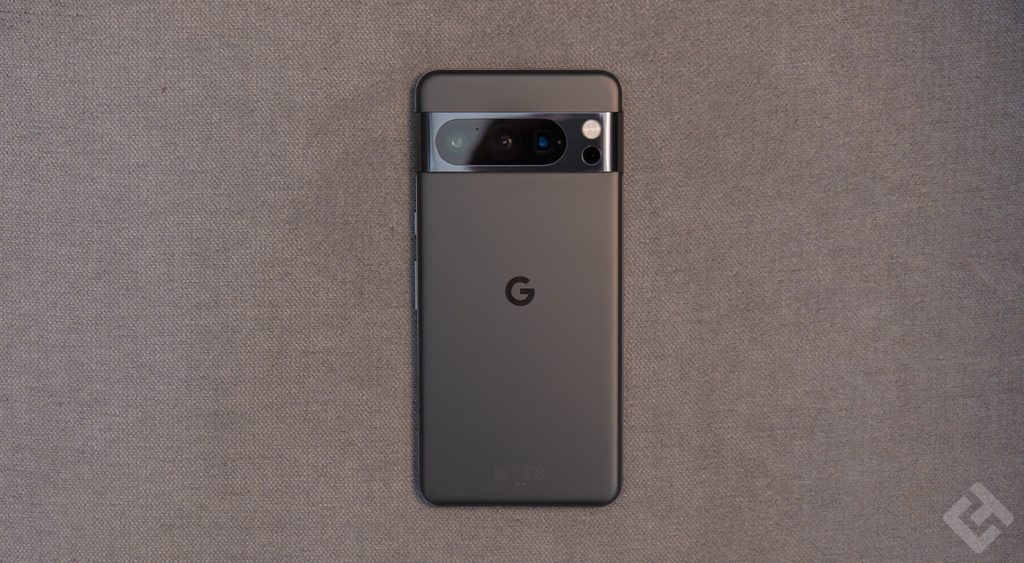
The new Pixel 8 retains a design similar to that of the previous generation, with essentially minor changes to the chassis. Apart from the use of enhanced Gorilla Glass Victus 2 on the front and back, and the flat screen, the Pixel 8 Pro uses the same materials, glass on both panels and aluminum for the chassis.
Dimensions are almost identical, although the 8 Pro is slightly smaller and more compact, probably due to the reduced borders. IP68 certification is still included in the list of features.
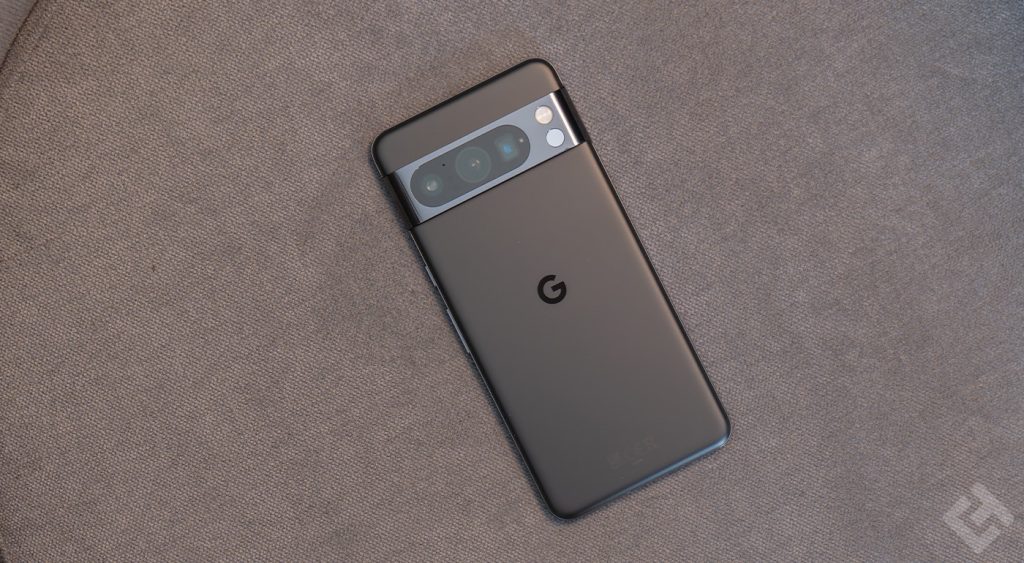
Two other relatively minor changes have been made to the design. Firstly, the corners of both the 8 and 8 Pro are now more rounded than last year, and the 8 Pro’s camera bulge slightly exceeds that of last year’s 7 Pro.
As for the camera bulge, all three sensors are now located behind a single piece of glass, and the LED flash is accompanied by a temperature sensor, but more on that later. The Pixel 8 Pro also retains the default Volcanic Black color and adds three new ones: Porcelain, Azure Blue and Mint Green.
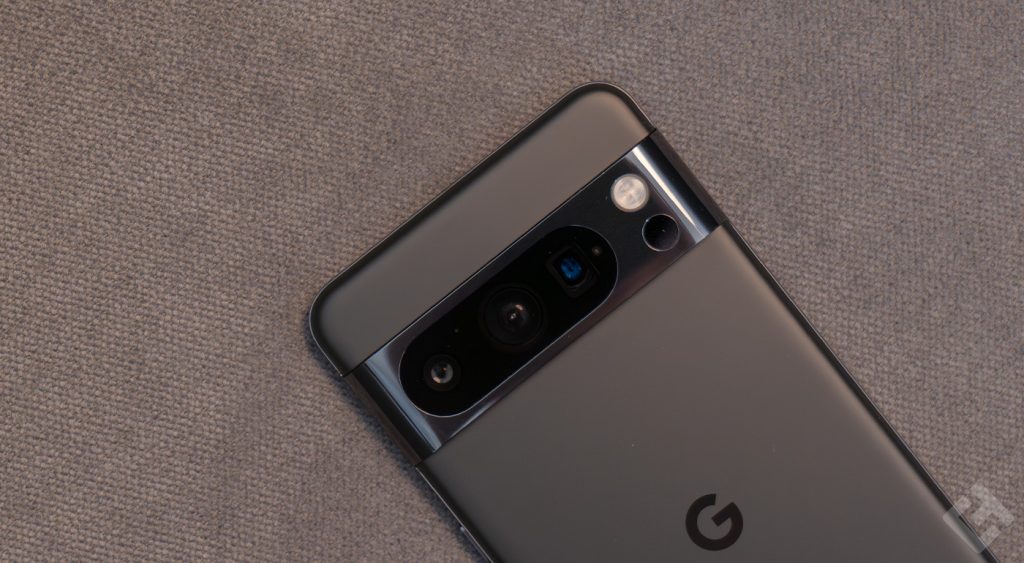
The Azure Blue color, for example, offers a light but still vivid blue tint that we haven’t seen from other manufacturers. Whatever the color, the back of the 8 Pro has a frosted matte finish that’s pleasant to the touch but also quite slippery. Fingerprints and smudges are not easily visible, which is appreciable. For our part, we received the smartphone in Volcanic Black.
Moving to the front, we notice slightly thinner edges, rounded corners and, as before, a centered cutout for the selfie camera. The most unexpected change is one of the biggest design changes of this generation: the curved front glass of yesteryear has given way to an almost entirely flat glass. The edges of the screen are still slightly rounded, allowing a smooth, almost imperceptible transition into the frame. However, the glass is far from “curved”.
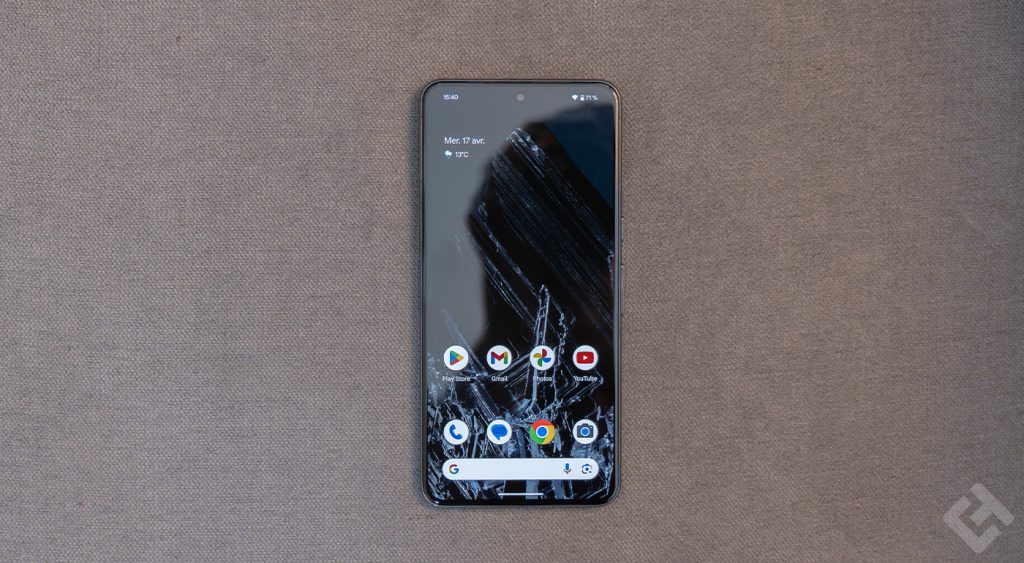
The side edges don’t deviate much from the norm, with a glossy finish and rounded edges, for the third consecutive generation of Pixel Pros. The usual elements are also present in the usual places, starting at the bottom, we can see the USB-C port and the “main” speaker grille.
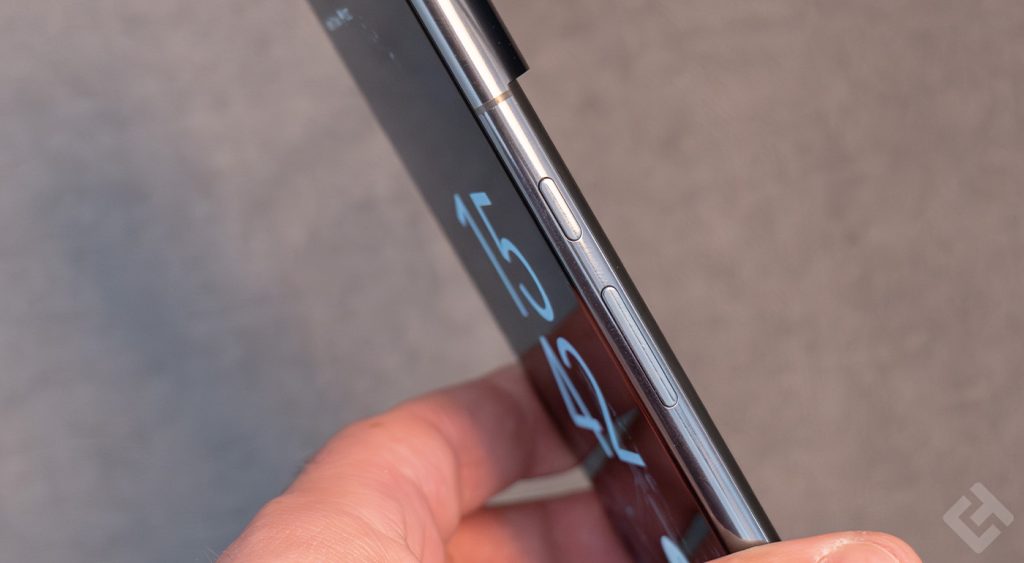
The volume and power buttons are on the right side – nothing particularly extraordinary, but they retain the distinctive Pixel touch. The power button is located above the volume button, which may take some getting used to if you’re coming from a different brand of phone, but at least both buttons are easily accessible with the right thumb (or left index and middle fingers).
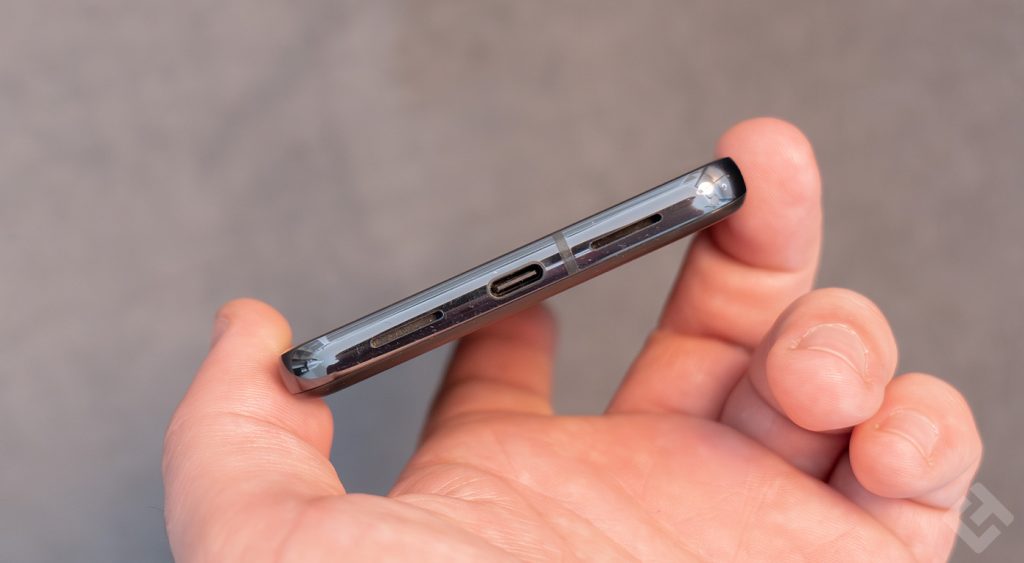

The glossy sides offer a very pleasant tactile feel and surprising grip. This is partly due to the fact that the flat screen allows the rails to be more pronounced than the curves of the Pixel 7 Pro’s screen allowed. Be that as it may, the frame offers a firm enough grip, and the device as a whole feels pleasant and secure in the hand.
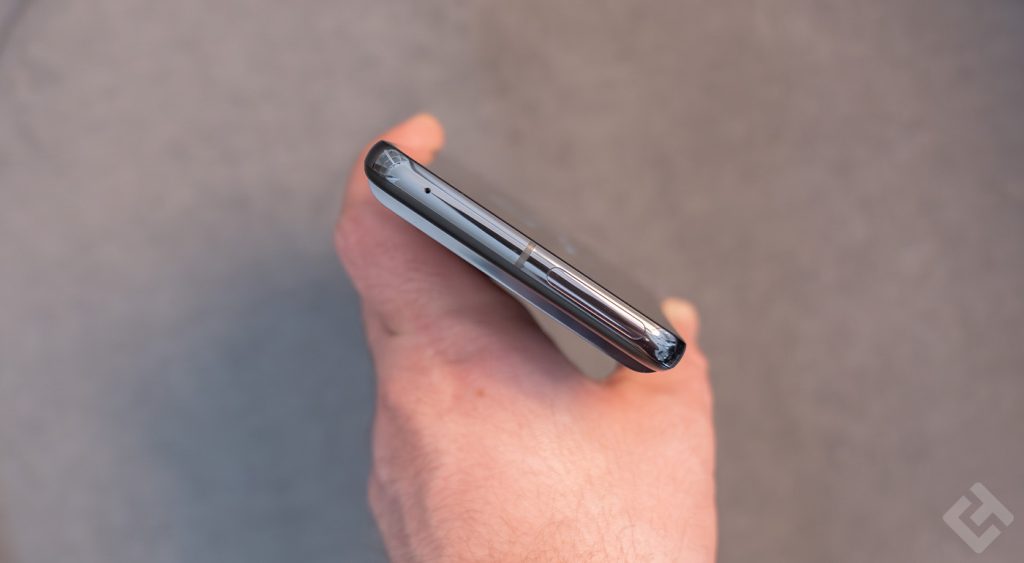
Overall, even for those using a two-year-old Pixel 6 Pro, the Pixel 8 Pro will be familiar. Google hasn’t introduced any major design changes, and for the most part, the Pixel 8 Pro resembles the Pixel 7 Pro and Pixel 6 Pro. However, many might consider the switch to a flat screen an important feature and thus find a reason to upgrade to the 8 Pro.
Google Pixel 8 Pro specifications
| Model | Google Pixel 8 Pro |
| Software | Android 14 |
| Processor | Google Tensor G3 |
| Overlay | No |
| RAM | 12 GB |
| Graphics processor (GPU) | Immortalis-G715s MC10 |
| Storage capacity | 128 GB |
| Screen size | 6.7-inch |
| Definition | 2992 x 1344 px |
| Pixel density | 489 dpi |
| Back camera |
|
| Front camera | 10.5 MP |
| Video | 4K / 60 fps |
| Wi-Fi | Wi-Fi 7 |
| Bluetooth | Bluetooth 5.3 |
| 5G compatible | Yes |
| NFC | Yes |
| Fingerprint sensor | Yes |
| Face recognition | Yes |
| Connections | USB-C |
| Battery capacity | 5,050 mAh |
| Wireless charging | Yes |
| Fast charging | 30 watts |
| Waterproofing | IP68 |
| Weight | 213 grams |
Google Pixel 8 Pro performance
This year, Google’s Pixel 8 Pro is powered by the Google Tensor G3 chipset, which performs better than last year’s. It’s made with more advanced technology, which should make it a little more efficient and less hot. What’s really great is that it has a processor with nine cores, which is a bit unusual.
This processor has a particular configuration with a large main core and eight other cores distributed to save energy. There’s also a new graphics processor that promises better performance for games and graphics-intensive applications.
On top of this, there are improvements for security and artificial intelligence. The phone has a special chip for security and a new processing unit for AI-related tasks, such as real-time translation and call filtering.
As for memory and storage, the Pixel 8 Pro has a version with 12GB of RAM, which is pretty impressive. As for storage, it offers versions with 128 GB, like the one received at the editorial office, 256 GB, 512 GB and even 1 TB.
As far as the processor is concerned, it’s not a performance monster; indeed, the latter lags fairly far behind elsewhere, against the Apple A17 and Snapdragon 8 Gen 2, even worse against the Honor Magic6 Pro’s Snapdragon 8 Gen 3.
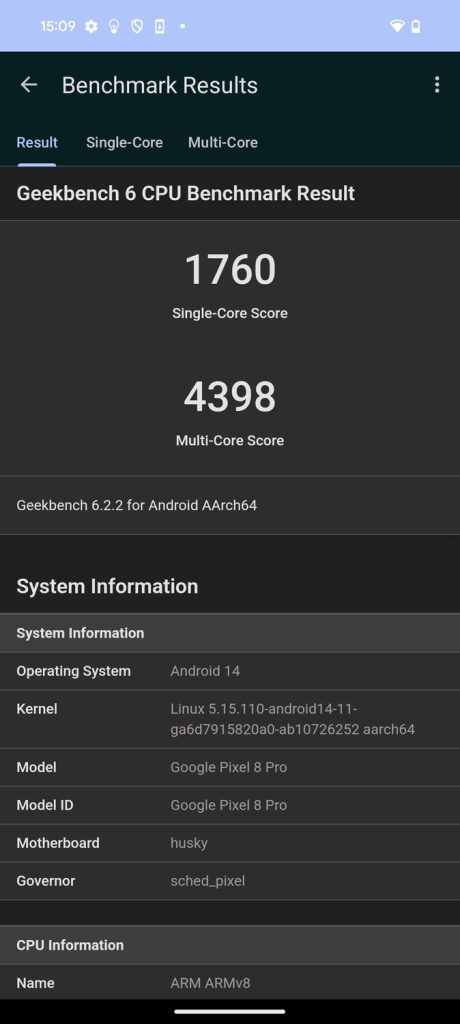
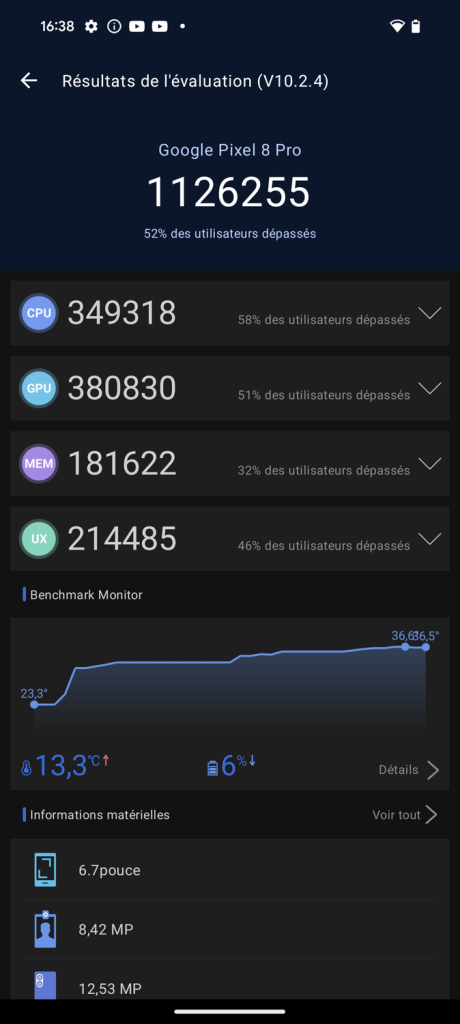
On Antutu as on GeekBench, I admit to being a little disappointed with the performance scores, however, are benchmark scores really indicative of the smartphone’s day-to-day use?
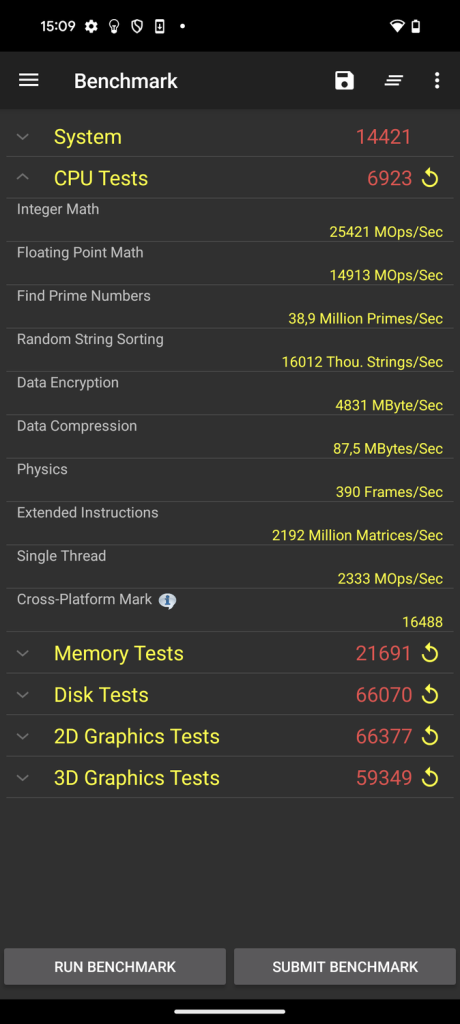
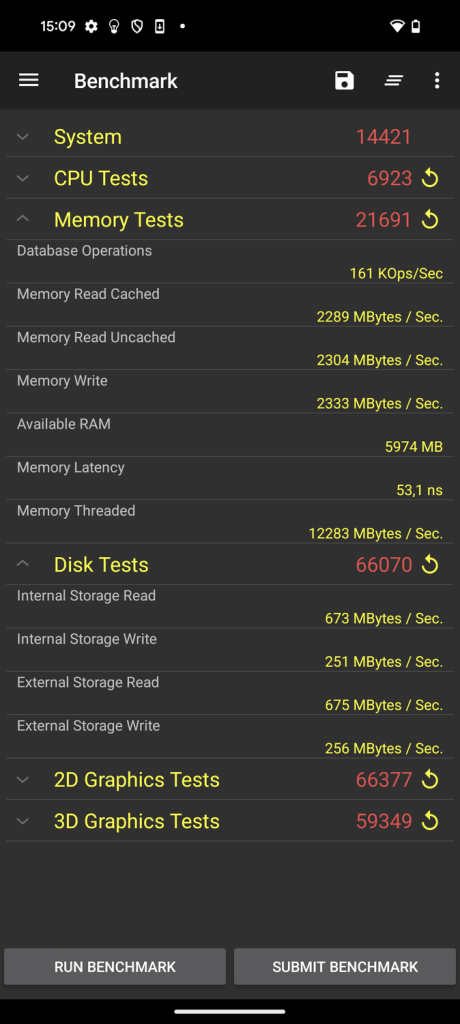

RAM speed is not extraordinary for such a smartphone, remembering that this is a high-end device. Nor are latencies as low as on other smartphones in the same category, and the storage chip frankly sucks in terms of throughput. Sure, it works, but when you compare it to what others are offering on paper, Google doesn’t seem to have bothered to come up with something really high-performance.
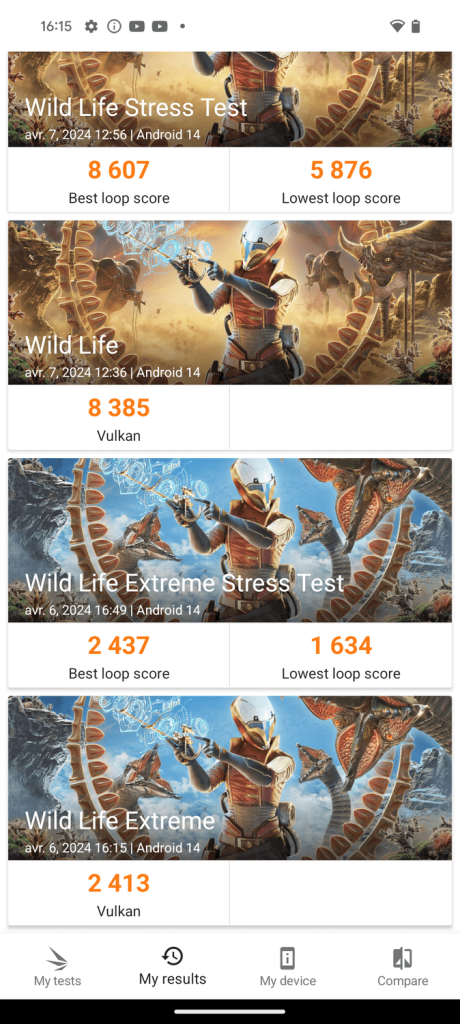
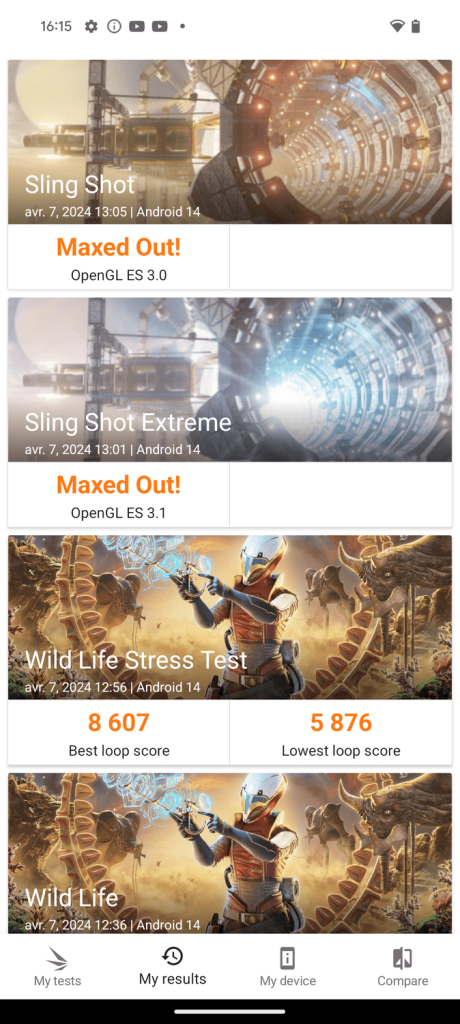
Finally, in terms of graphics performance, it’s not bad. The Google Pixel 8 Pro performs well, scoring highly in most 3DMark benchmarks, and there’s no doubt about it when it comes to gaming: I had no problems with fluidity or anything else.
Google Pixel 8 Pro screen
The Pixel 8 Pro features an impressive screen called Super Actua, with an incredibly high maximum brightness of up to 2400 nits. This 6.7-inch OLED LTPO screen offers a somewhat unusual resolution of 2992 x 1344 pixels, which means it’s very sharp with a pixel density of 489 pixels per inch. It can also refresh up to 120 times per second, making it very fluid, and supports HDR10+ for impressive color and contrast, although it doesn’t support Dolby Vision.
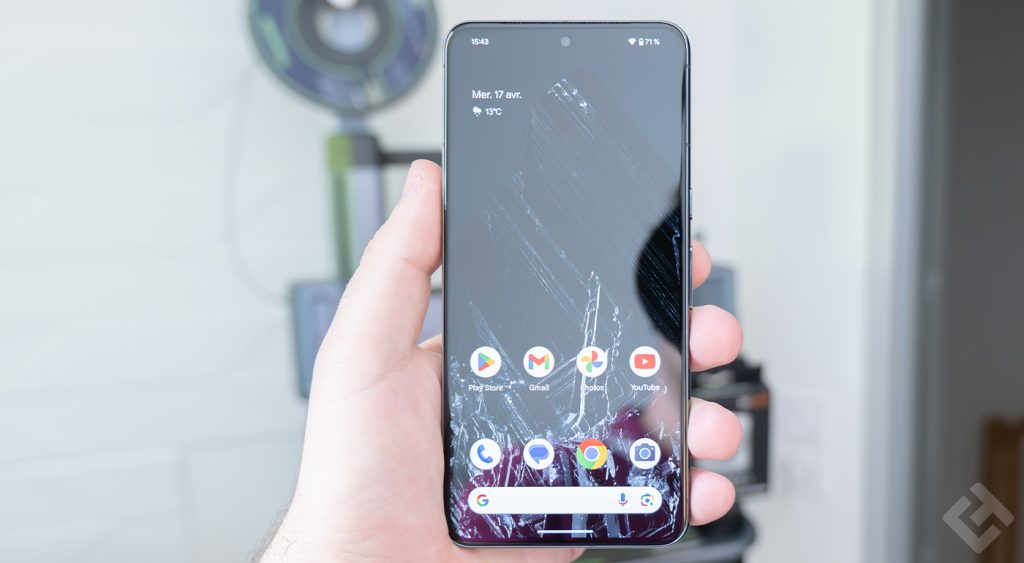
The phone offers two color modes: an adaptive mode that makes colors more vivid, and a natural mode that’s better suited to more natural sRGB colors. Both modes offer good color accuracy, but some might prefer the natural mode for its fidelity. What’s more, there are no major color shift problems, so the absence of color temperature adjustment isn’t really a problem.
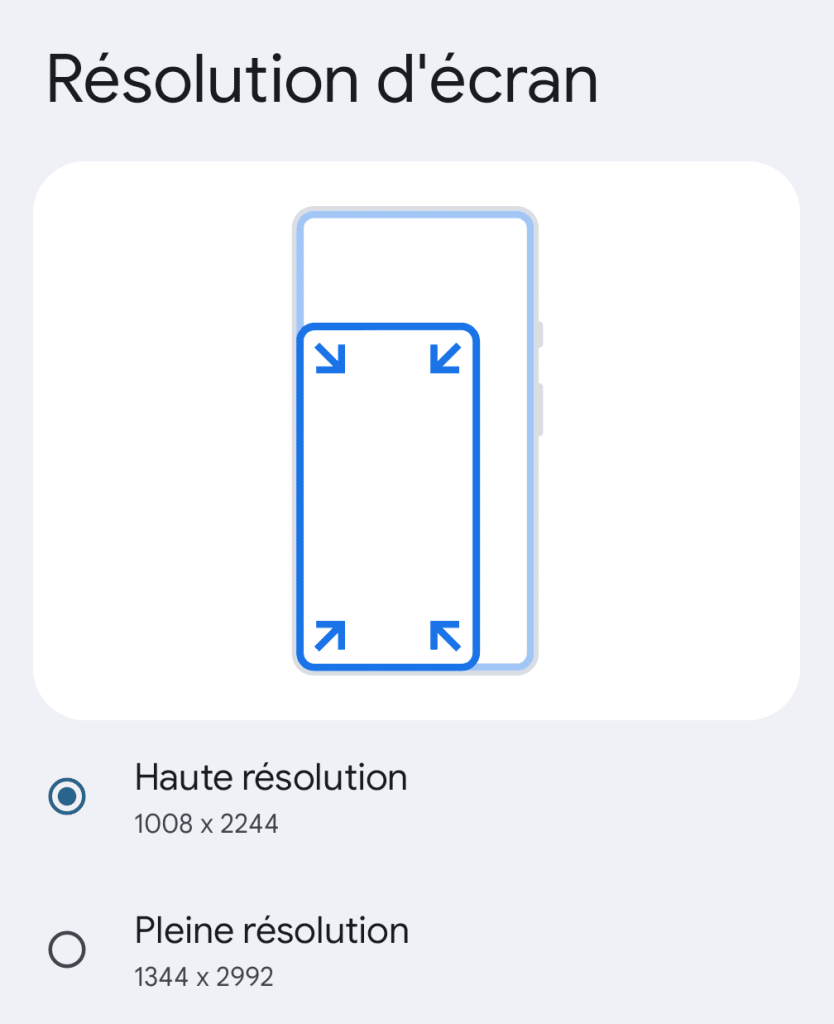
Refresh rate management is straightforward: there’s a switch to activate “Smooth Display” mode, which lets you enjoy the maximum refresh rate of 120 Hz for an ultra-smooth experience. But even if you don’t activate it, the phone automatically adjusts its refresh rate, going down to 1 Hz to save energy, with a maximum of 60 Hz when smooth mode is deactivated.
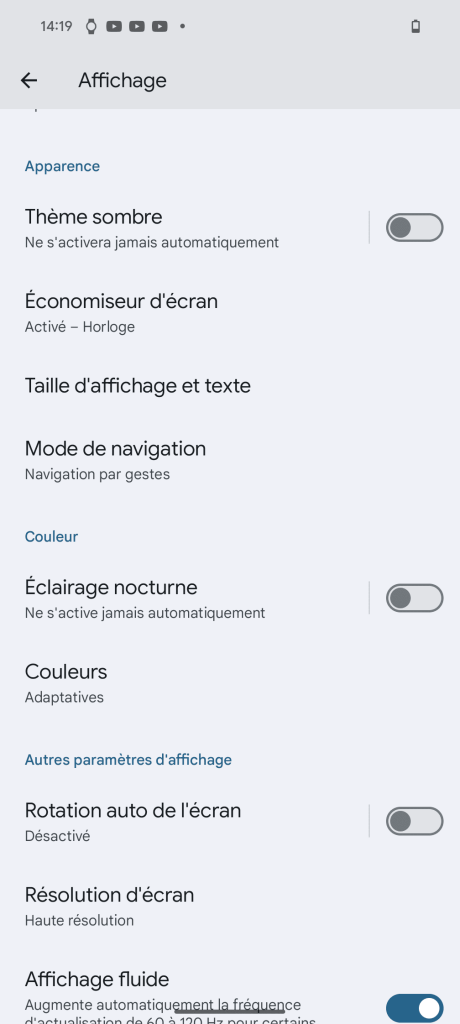
Indeed, the Pixel 8 Pro is pretty smart when it comes to its refresh rate. As soon as there’s no more touch activity and brightness is set at 20% or more, it quickly switches to 1 Hz to save energy. At lower brightness settings, it slows down to 10 Hz.

As for video playback, the phone generally stays at 60 Hz, even for videos shot at 24 or 48 frames per second, as Android suggests. However, when browsing the web or using apps, it maintains either 120 Hz or 60 Hz, depending on your preference, but can go down to 1 Hz when the content is static and there’s no touch input. And if you play games that support high frame rates, you can also take advantage of the high refresh rate.
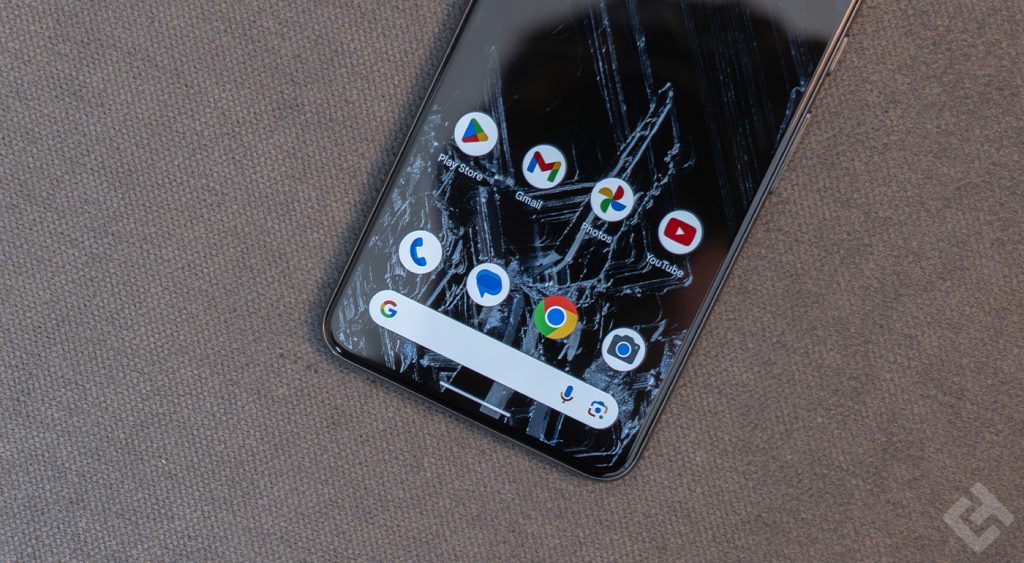
The Pixel 8 Pro supports HDR10 and HDR10+, which is great for watching HDR content on platforms like YouTube and Netflix. You’ll also notice that when you watch an HDR video in a window, only that window benefits from the increased brightness, which is a nice attention to detail. This feature has been present on OLED iPhones for a while now, and now it’s also available on Pixels, with other Android phones set to follow next year.
Pixel 8 Pro camera
As expected, the Pixel 8 Pro’s main camera delivers excellent daylight performance. While its 50-megapixel resolution is no different from most other phones, the Pixel still manages to capture detail in a way that sets it apart from its competitors. Photos are remarkably sharp, with very little noise even when examined closely.
Tonal processing follows the Pixel tradition, with focus on highlights and generally high contrast, which can sometimes make shadows a little darker than other phones would produce. This year, however, there seems to be a slight trend towards slightly brighter images.


Automatic white balance is reliable and consistent, although it tends to lean slightly towards cooler settings, with a touch of magenta typical of Pixel devices. Moreover, color saturation is well balanced, offering images that are neither bland nor over-saturated.
Unlike the Pixel 8, the 8 Pro lets you shoot at the nominal resolution of each device. This means you can get a little more detail by shooting at 50 megapixels with the main camera, depending on subject, distance and lighting, without compromising overall image quality.


The Pixel 8 Pro’s 2x zoom captures decent photos, although sometimes they aren’t very sharp when examined in detail. For example, areas with a lot of detail can appear a little blurred, especially if the subject was moving when the shot was taken. However, for less complex scenes, the results are generally very satisfactory.
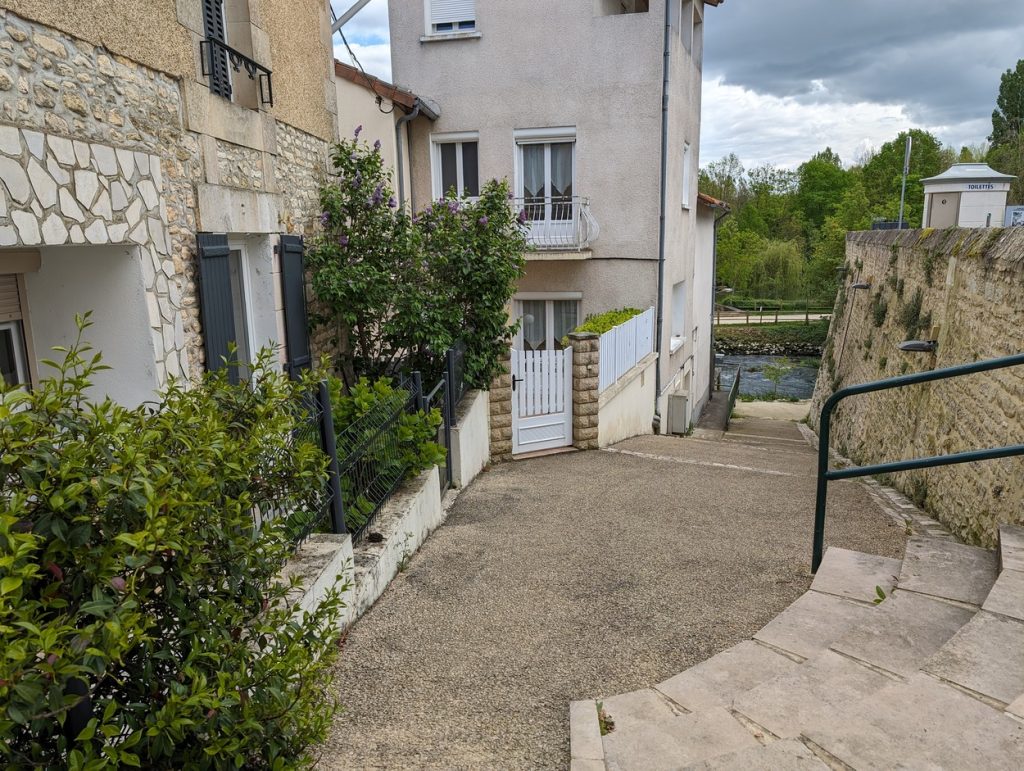

Interestingly, the Pixel 8 Pro can also record 50-megapixel photos using the 2x zoom. However, these photos appear enlarged and may not justify the file size.


The Pixel 8 Pro’s telephoto lens is one of its star features compared to the standard version. Captured images are sharp, detailed and offer a noticeable improvement over the previous generation, thanks to a new, more powerful optic. Image quality is consistent with that of the main camera, with good dynamic range and faithful, well-saturated colors.


The Pixel 8 Pro’s improved ultra-wide screen also produces high-quality photos. Details are impressive, and sharpness is maintained even in the farthest corners. Dynamic range and colors are also outstanding.




The ultra-wide full-resolution mode lacks a little sharpness, raising questions about its usefulness. However, it is appreciable that it does not compromise the overall quality of the camera.



What is indisputable is the usefulness of the ultra-wide lens for close-up shots. Not only is it ideal for ordinary shots of close-up objects, such as the aforementioned Lego, but it also excels in the Pixel 8 Pro’s “Macro” mode. The camera cleverly crops the central part of the ultra-wide sensor to match the main camera’s field of view, resulting in sharper, more detailed photos. This is where the Pixel 8 Pro’s ultra-wide lens shows its superiority over the standard model.
Google Pixel 8 Pro software
As in the past, Google places a strong emphasis on the overall software experience of its new Pixel 8 and 8 Pro. While these phones don’t introduce any revolutionary, flashy features, they do aim to make your daily life easier, at least if you live in a supported region. Like their predecessors, the Pixel 8 and 8 Pro truly embody the essence of a smartphone, offering smart features such as call screening, real-time translation and a comprehensive set of image-editing tools.
All these features are made possible by Google’s enhanced NPU, which speeds up AI-related tasks. However, it’s important to note that some of these features require a permanent internet connection, as some AI-related operations are performed on Google’s cloud servers.
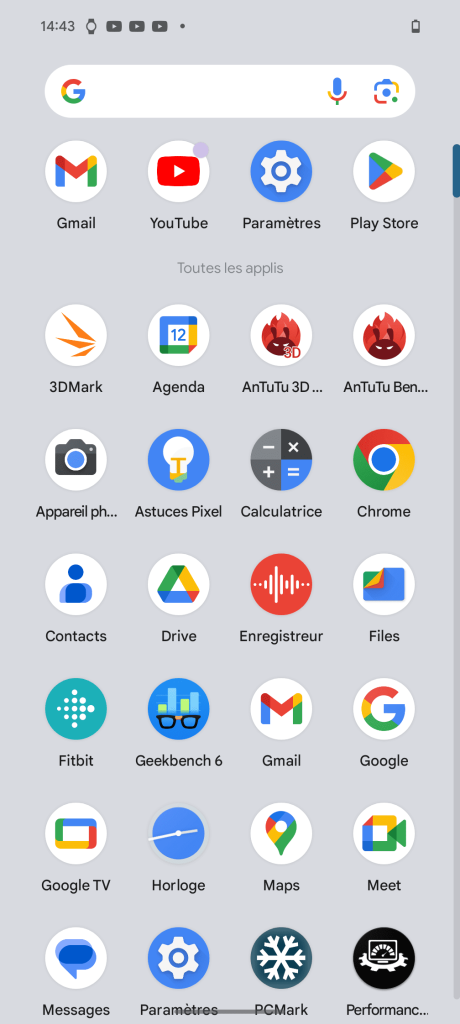
Android 14 doesn’t feature any significant changes compared to Android 13 in terms of overall appearance and user interface design. If you’re familiar with stock Android, you’ll immediately feel at home. The lock screen, home screen, notification shade, quick buttons, recent apps and app drawer remain unchanged. The only notable difference is that the notification screen now displays a list of apps running in the background, which could be useful for spotting those affecting your phone’s battery life.

Android 14 simplifies image creation with new generative AI features, allowing you to create unique, high-quality wallpapers. The menu system offers 12 main styles, plus a multitude of word and color combinations.
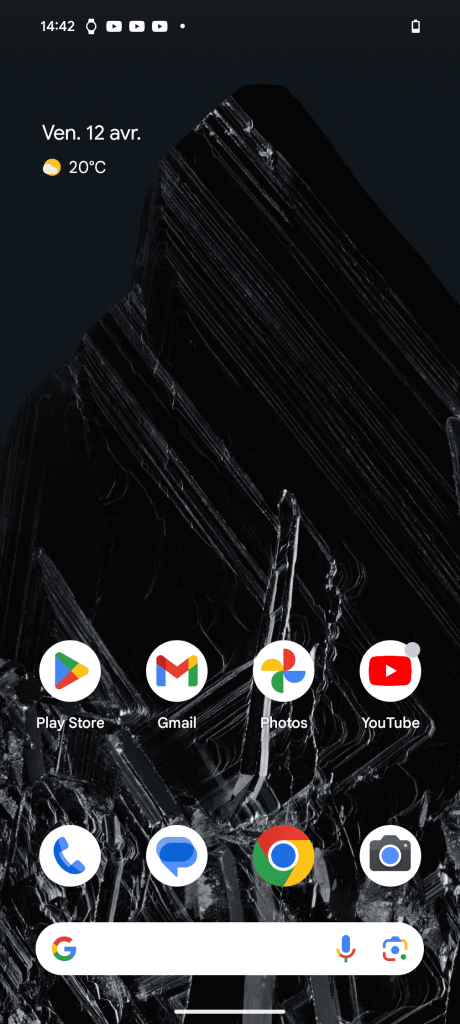
What’s more, Android 14 gives you the option of selecting a regional language while using different measurement, date and week settings. For example, if you’re a European living in the USA, you can still choose the USA as your main region while using the metric system. You can also select the language by application.
In terms of under-the-hood improvements, the software team has made a few tweaks to improve efficiency and battery life. However, these changes remain minor and should not result in significant differences in daily use.
Google Pixel 8 Pro battery life
The Pixel 8 Pro features a 5,050 mAh battery, which represents an increase of just 1% over the previous generation. Unfortunately, this slight improvement doesn’t really have a significant impact. In terms of equipment, the Pixel 8 Pro is roughly comparable to other high-end Android smartphones.
However, in terms of battery life, the smartphone doesn’t quite rival its rivals. Active use figures are lower than those of the Galaxy S23 Ultra and iPhone 15 Pro Max, particularly in the case of the latter. What’s more, it doesn’t offer notably better battery life than the standard Pixel 8
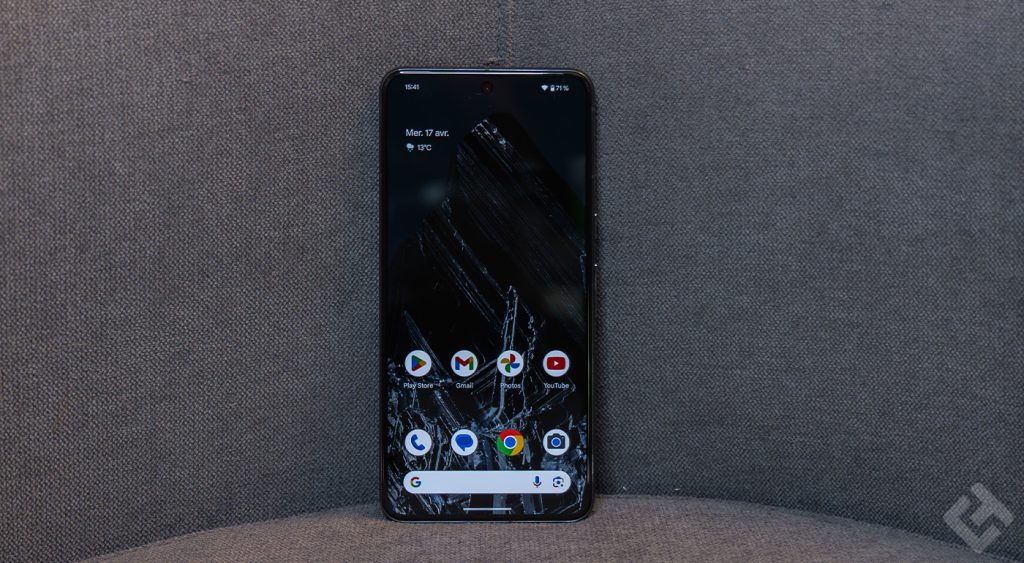
Pixels have often been criticized for their slow charging speed. While the Pixel 8 Pro doesn’t revolutionize this, we did see significant improvements in our tests. Using Google’s official 30W charger (or any modern USB Power Delivery charger of equivalent or higher power), the Pixel 8 Pro achieved a full charge in 1h23, an improvement of around 30 minutes on the Pixel 7 Pro, which was already quite slow.
Although this is still slower than the performance of some competitors, such as the iPhone 15 Pro Max and the Galaxy S23 Ultra, the Pixel 8 Pro shows appreciable progress. On the other hand, after 30 minutes, we saw an improvement on the previous generation, but the Pixel still doesn’t reach the speed levels of its rivals.
Sound quality of the Google Pixel 8 Pro
The Pixel 8 Pro continues the tradition of hybrid stereo speakers. In portrait mode, the top speaker emits the left channel, while in landscape mode, the channels are adjusted according to orientation. In both cases, each speaker also broadcasts the other channel’s track, albeit slightly attenuated.
The sound quality of the Google Pixel 8 Pro is fully satisfactory – it’s not a bad smartphone, far from it. It’s not a bad smartphone, far from it. In fact, it performs well, but when the sound is turned up to the max, it tends to be somewhat less pleasant.
Google Pixel 8 Pro connectivity
The Google Pixel 8 Pro benefits from excellent cellular frequency coverage, offering extensive connectivity with 4G and 5G compatibility. This guarantees optimal signal reception in most situations.
Here’s the list of cellular bands compatible with the smartphone:
| 2G | 850, 900, 1800 and 1900 MHz |
| 3G | 1, 2, 4, 5, 6, 8, 19 |
| 4G | B1/2/3/4/5/7/8/12/13/14/17/18/19/20/25/26/28/30/32/38/40/41/42/46/48/66/71 |
| 5G | n1/2/3/5/7/8/12/20/25/28/30/38/40/41/66/71/75/76/77/78 |
On top of that, the Google Pixel 8 Pro offers Wi-Fi 7 and Bluetooth 5.3 connectivity, as well as NFC naturally. The smartphone features a USB-C 3.2 connector for charging as well as data transfer via OTG.
Locking and security
Like most smartphones in this price range, the Google Pixel 8 Pro offers two quick unlocking methods: an integrated fingerprint sensor under the screen and facial recognition.
Fingerprint unlocking is done by placing your thumb on the side power button. This method is configured via the device’s settings, as shown in the screenshot provided, and I found no problems whatsoever.
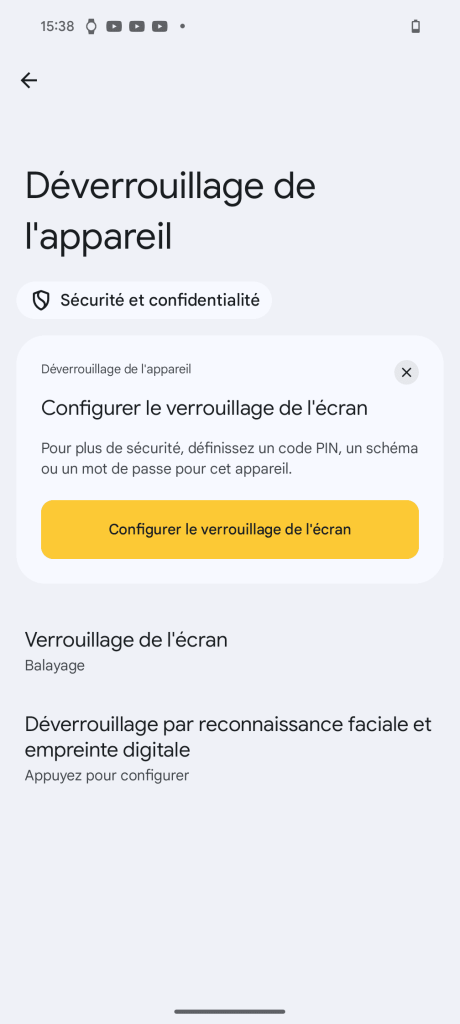
As for facial recognition, the experience was fairly predictable. Unlocking works well during the day, although it remains vulnerable to a decent photo of the user. However, facial recognition is often less effective at night, unless exposed to strong direct light.
Google Pixel 8 Pro : Reviews
Google has done a really good job with the Google Pixel 8 Pro. Indeed, it’s an excellent smartphone in every respect, although it doesn’t necessarily stand out from the competition. But in terms of photography and performance, I confess I was pleasantly surprised.
Only the phone’s autonomy, which is a little below the average of other devices in a similar range, could be a minor disappointment. On top of that, let me add that fast charging isn’t all that fast, when compared with theAsus Zenfone 11 Ultra, for example.

